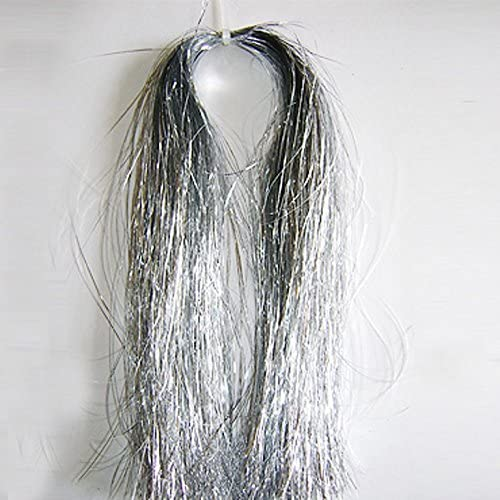2, Electrostatics
Floating orbs and will-o'-wisps
In chapter 2, Kate meets a Will-o'-wisp (which I think must be a bit like intelligent ball lightning).
Will-o'-wisps generate high levels of will-o'-power, that’s how they glow and float.
We can’t generate will-o'-power, but we can do something similar.
In this experiment, we're going to make a floating tinsel orb. We'll use static electricity to make a ball of tinsel float in the air, much the same way as will-o'-wisps do.
You will need
- 1 inch or 2.5 cm wide PVC Pipe about 24 inches or 60cm long. You can also use a regular balloon if you do not have PVC pipe.
- Mylar tinsel for Christmas trees. We’ve included tinsel that worked for us in the Kate Witch set. The tinsel is important. It must be mylar and it must be light. It should look something like this:

- A wool blanket, silk scarf that sort of thing. I found a wool jumper worked best. Try a selection of different things. Even your hair can work (but is not so easy).
- Scissors
What to do
There are instructions below or you can watch this video.
Notice — it takes him a while to find something that produces enough static.
Here’s the written instructions:
(from the amazing wizard, Science Bob.)
- Arrange 6 strands of tinsel together and tie them together in a knot at one end.
- Tie them together again about 6 inches or 15 cm from the first knot.
- Cut the loose mylar strands off just past each knot. See the cover picture for the youtube video. It should look like that.
- Charge the PVC pipe with static by rubbing it back and forth through wool (or hair / silk). See what works for you.
- Hold the tinsel orb by the knot above the charged pipe and let it drop and touch the pipe. It should repel away and start floating. This is the tricky part. Often the tinsel will stick fast to the pipe. We had to give the pipe a hard flick to get it in the air. The tinsel is now negatively charged and will become attracted to positively charged things (like people, desks, lights, well most things). You need some space.
- Top tip: Pull the tinsel into a ball shape so the tinsel is separated before dropping it. If it sticks, try flicking it up and off.
- Practice! It takes some time to get it, but wow it’s fun!(You will usually have to “recharge” the pipe before each levitation.)
How does it work?
It is all about static charges. Similar static charges repel away from each other. When you rub the pipe you give the pipe a negative static charge. The orb is attracted to the pipe at first because the orb has a positive charge. As soon as the orb touches the pipe, it picks up a negative charge.
Since the pipe is negative and the tinsel orb is now negative, they repel away from each other and the orb levitates.
The orb will also take on more of a “ball” appearance when charged since all the tinsel strands are repelling away from each other.
Did you notice the orb is attracted to other objects around you — including you? That is because most objects (including you) have a positive charge.
Video: Static electricity
Let's make it an experiment
The project above is a DEMONSTRATION, it shows something, however an experiment answers something. To make it a true experiment, you can try to answer these questions:
Does the number of mylar strands affect how well the orb levitates?
Do different materials (hair, fur, wool) build up better static charges?
How long does the static charge last / how can you make it last longer?
Do different widths of pipe affect the floating ability of the orb?
Questions
What are other examples of static electricity in nature?
How do your examples work (become charged)